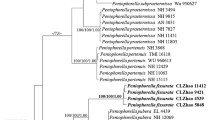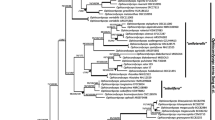Abstract
A new species, Paraxerula ellipsospora, is described from southwestern China using both morphological and molecular phylogenetic evidence. This species differs phenotypically from the three known species in the genus by its greyish colored pileus, ellipsoid to elongate basidiospores, and a distribution in pine forests in Yunnan. Geographical divergences of Paraxerula in the Holarctic were observed. All species show continental endemisms, yet related species occurring in East Asia and in Europe, or in East Asia and in North America were found.




Similar content being viewed by others
References
Bas C (1969) Morphology and subdivision of Amanita and a monograph of its section Lepidella. Persoonia 5:285–579
Boekhout T (1999) Oudemansiella and Xerula. In: Bas C, Kuyper Th W, Noordeloos ME, Vellinga EC (eds.) Flora Agaricina Neerlandica 4. A. A. Balkema Publishers, Rotterdam, pp 177–178, 181–184
Boekhout T, Bas C (1986) Notulae ad floram agaricinam Neerlandicam-XII. Some notes on the genera Oudemansiella and Xerula. Persoonia 13:45–56
Bon M (1975) Agaricales de la côte atlantique Française. Doc Mycol 5:31–38
Clémençon H (1979) Taxonomic structure of the genus Oudemansiella (Agaricales). Sydowia 32:74–80
Contu M (2000) Il genere Xerula (Basidiomycotina, Agaricales) nell’Italia centro-meridionale de insulare. Micol Veg Mediterr 15:18–39
Dörfelt H (1983) Taxonomische Studien in der Gattung Xerula R. Mre. IV. Feddes Repert 93:43–85
Doyle JJ, Doyle JL (1987) A rapid DNA isolation procedure for small quantities of fresh leaf tissue. Phytochem Bull 19:11–15
Feng B, Xu J, Wu G, Hosen MI, Zeng NK, Li YC, Tolgor B, Kost GW, Yang ZL (2012) DNA sequence analyses reveal abundant diversity, endemism and evidence for Asian origin of the porcini mushrooms. PLoS One 7:e37567
Geml J, Laursen GA, O’Neill K, Nusbaum HC, Taylor DL (2006) Beringian origins and cryptic speciation events in the fly agaric (Amanita muscaria). Mol Ecol 15:225–239
Geml J, Tulloss RE, Laursen GA, Sazanova NA, Taylor DL (2008) Evidence for strong inter- and intracontinental phylogeographic structure in Amanita muscaria, a wind-dispersed ectomycorrhizal basidiomycete. Mol Phylogenet Evol 48:694–701
Hall TA (1999) BioEdit: a user-friendly biological sequence alignment editor and analysis program for Windows 95/98/NT. Nucleic Acids Symp Ser 41:95–98
Jenkinson TS, Perry BA, Schaefer RE, Desjardin DE (2013) Cryptomarasmius gen. nov. established in the Physalacriaceae to accommodate members of Marasmius section Hygrometrici. Mycologia. doi:10.3852/11–309
Kornerup A, Wanscher JH (1981) Taschenlexikon der Farben. 3. Aufl. Muster-Schmidt Verlag, Göttingen
Li YC, Yang ZL, Tolgor B (2009) Phylogenetic and biogeographic relationships of Chroogomphus species as inferred from molecular and morphological data. Fungal Divers 38:85–104
Mizuta Y (2005) Oudemansiella japonica and Oudemansiella hongoi rediscovered from Japan. Nippon Kingakukai Kaiho 46:25–31
Mueller GM, Wu QX, Huang YQ, Guo SY, Aldana-Gomez R, Vilgalys R (2001) Assessing biogeographic relationships between North American and Chinese macrofungi. J Biogeogr 28:271–281
Nylander J (2004) MrModeltest v2.3. Program distributed by the author. Uppsala (Sweden): Evolutionary Biology Centre, Uppsala University.
Pegler DN, Young TWK (1987) (1986)] Classification of Oudemansiella (Basidiomycota: Tricholomataceae), with special reference to spore structure. Trans Br Mycol Soc 87:583–602
Petersen RH, Hughes KW (2010) The Xerula/Oudemansiella complex. Nova Hedwig Beih 137:1–625
Redhead SA (1989) A biogeographical overview of the Canadian mushroom flora. Can J Bot 67:3003–3062
Rehner SA (2001) Primers for elongation factor 1-α (EF1-α). http://www.aftol.org/pdfs/EF1primer.pdf
Reid DA (1985) Further records of Jersey fungi. Trans Br Mycol Soc 84:715–722
Ridgway R (1912) Color standards and color nomenclature. Publ. by the author, Washington D.C.
Ronikier A (2003) Revision of the genus Xerula Maire (Basidiomycetes, Agaricales) in Poland. Acta Soc Bot Pol 72:339–345
Ronquist F, Huelsenbeck JP (2003) MrBayes 3: Bayesian phylogenetic inference under mixed models. Bioinformatics 19:1572–1574
Seibel PN, Müller T, Dandekar T, Schultz J, Wolf M (2006) 4SALE—A tool for synchronous RNA sequence and secondary structure alignment and editing. BMC Bioinforma 7:498
Smith SA, Dunn CW (2008) Phyutility: a phyloinformatics tool for trees, alignments and molecular data. Bioinformatics 24:715–716
Stamatakis A (2006) RAxML-VI-HPC: maximum likelihood-based phylogenetic analyses with thousands of taxa and mixed models. Bioinformatics 22:2688–2690
Swofford DL (2002) PAUP*. Phylogenetic analysis using parsimony (*and other methods), version 4.0b10. Sinauer Associates, Sunderland
Vellinga EC (2010) Book reviews and notices. Mycotaxon 114:487–500
Vellinga EC, Noordeloos ME (2001) Glossary. In: Noordeloos ME et al (eds) Flora Agaricina Neerlandica, vol 5. A.A. Balkema, Rotterdam, pp 6–11
Vilgalys R, Hester M (1990) Rapid genetic identification and mapping of enzymatically amplified ribosomal DNA from several Cryptococcus species. J Bacteriol 172:4238–4246
Vizzini A, Ercole E, Voyron S (2012) Laccariopsis, a new genus for Hydropus mediterraneus (Basidiomycota, Agaricales). Mycotaxon 121:393–403
Wheeler TJ, Kececioglu JD (2007) Opal: software for aligning multiple biological sequences. Version 0.3.7. Available at http://opal.cs.arizona.edu.
White TJ, Bruns T, Lee S, Taylor J (1990) Amplification and direct sequencing of fungal ribosomal RNA genes for phylogenies. In: Innis MA, Gelfand DH, Sninsky JJ, White TJ (eds) PCR protocols, a guide to methods and applications. Academic, San Diego
Yang ZL (2000) Further notes on the genus Oudemansiella from southwestern China. Mycotaxon 74:357–366
Yang ZL, Zang M (1993) Classification of the genus Oudemansiella Speg. in southwest China. Acta Mycol Sin 12:16–27
Yang ZL, Zhang LF, Mueller GM, Kost GW, Rexer K-H (2009) A new systematic arrangement of the genus Oudemansiella s. str. (Physalacriaceae, Agaricales). Mycosystema 28:1–13
Zhao Q, Feng B, Yang ZL, Dai YC, Wang Z, Tolgor B (2012) New species and distinctive geographical divergences of the genus Sparassis (Basidiomycota): evidence from morphological and molecular data. Mycol Prog 12:445–454
Acknowledgments
The authors are very grateful to Egon Horak (Austria), S. Takehashi (Japan), R. Halling (USA), the late Prof. Mu Zang, Bang Feng, Qi Zhao and Li-Ping Tang (Kunming Institute of Botany, Chinese Academy of Sciences, KIB) for providing specimens. Xiang-Hua Wang (KIB) is thanked for providing a valuable image of P. hongoi. Guo-Fu Qin and Jun Zhao (General Station of Forest Pest Control, State Forestry Administration of China, GSFPC), Han-Cheng Wang (Chongqing Normal University) and Ting Guo (KIB) are acknowledged for providing sequences of β-tubulin primers. This work was supported by the National Natural Science Foundation of China (No. 31170024) and by the Knowledge Innovation Program of the Chinese Academy of Sciences (No. KSCX2-EW-Z-9).
Author information
Authors and Affiliations
Corresponding author
Rights and permissions
About this article
Cite this article
Qin, J., Hao, YJ., Yang, Z.L. et al. Paraxerula ellipsospora, a new Asian species of Physalacriaceae. Mycol Progress 13, 639–647 (2014). https://doi.org/10.1007/s11557-013-0946-y
Received:
Revised:
Accepted:
Published:
Issue Date:
DOI: https://doi.org/10.1007/s11557-013-0946-y




